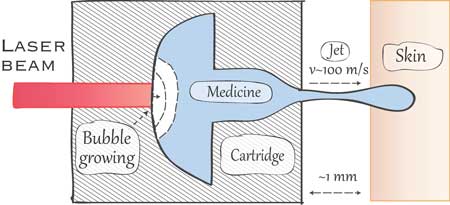| Apr 16, 2019 | |
Getting a smart tattoo without using any needle(Nanowerk News) A tattoo that is warning you for too many hours of sunlight exposure, or is alerting you for taking your medication? Next to their cosmetic role, tattoos could get new functionality using intelligent ink. That would require more precise and less invasive injection technique. |
|
| Researchers of the University of Twente now develop a micro-jet injection technology that doesn’t use needles at all. Instead, an ultrafast liquid jet with the thickness of a human hair penetrates the skin. It isn’t painful and there is less waste. | |
| In their new publication in the American Journal of Physics ("High speed imaging of solid needle and liquid micro-jet injections"), the scientists compare both the needle and the fluid jet approach. | |
 |
|
| A laser heats the liquid in a microchannel. A vapour bubble grows fast, causing the liquid (containing medication or ink) to be ejected out of the channel at high speed. (Image: University of Twente) | |
| Ötzi the Iceman already had, over 5000 years ago, dozens of simple tattoos on his body, apparently for pain relief. Since the classic ‘anchor’ tattoo that sailors had on their arms, tattoos have become more and more common. | |
| About 44 million Europeans wear one or more of them. Despite its wider acceptance in society, the underlying technique didn’t change and still has health risks. One or more moving needles put ink underneath the skin surface. | |
| This is painful and can damage the skin. Apart from that, needles have to be disposed of in a responsible way, and quite some ink is wasted. The alternative that David Fernández Rivas and his colleagues are developing, doesn’t use any needles. | |
| In their new paper, they compare this new approach with classic needle technology, on an artificial skin material and using high speed images. Remarkably, according to Fernández Rivas, the classic needle technology has never been subject of research in such a thorough way, using high speed images. | |
Fast fluid jet |
|
| The new technique employs a laser for rapidly heating a fluid that is inside a microchannel on a glass chip. Heated above the boiling point, a vapour bubble forms and grows, pushing the liquid out at speeds up to 100 meter per second (360 km/h). The jet, about the diameter of a human hair, is capable of going through human skin. | |
| “You don’t feel much of it, no more than a mosquito bite”, say Fernandez Rivas. A short video interview with him can be found here. | |
| The researchers did their experiments with a number of commercially available inks. Compared to a tattoo machine, the micro-jet consumes a small amount of energy. What’s more important, it minimizes skin damage and the injection efficiency is much higher, there is no loss of fluids. And there is no risk of contaminated needles. | |
| The current microjet is a single one, while tattooing is often done using multiple needles with different types or colours of ink. Also, the volume that can be ‘delivered’ by the microjet has to be increased. These are next steps in developing the needle-free technology. | |
Skin treatment |
|
| In today’s medical world, tattoo-resembling techniques are used for treatment of skin, masking scars, or treating hair diseases. These are other areas in which the new technique can be used, as well as in vaccination. A challenging idea is using tattoos for cosmetic purposes and as health sensors at the same time. What if ink is light-sensitive or responds to certain substances that are present in the skin or in sweat? |
| Source: University of Twente | |
|
Subscribe to a free copy of one of our daily Nanowerk Newsletter Email Digests with a compilation of all of the day's news. |
